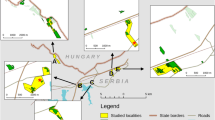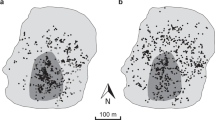Abstract
The loss of butterfly diversity in north-western Europe has been studied extensively but much less is known about the status of other macrolepidoptera. The present paper presents results of the research on mainly day-flying larger moths carried out by Dutch Butterfly Conservation in The Netherlands. Research started in 1992 with a public campaign and a mapping programme, leading to an increase in the number of records of macrolepidoptera. Results from the mapping programme on day-flying moths showed a strong general decrease in The Netherlands, comparable with the loss of butterfly diversity. Transect counts have been undertaken since 2000 for a few species and this method is sufficient to measure trends over time if the moth densities are high enough. Another research component was to focus on marshland habitats in The Netherlands. Fifty-five characteristic marshland moth species were selected and the relative abundance of nearly all these species has declined. These trends were compared with four other countries in the Atlantic biogeographical zone. The relative abundance of the majority of marshland moths in The Netherlands was found to be higher than those in other European countries, so that The Netherlands has a special responsibility for the conservation of the moths of its marshes. Moreover, we emphasise that, next to butterflies, moths can be of great use in nature conservation because of their potential significance as indicator species in endangered habitats.
Similar content being viewed by others
References
Bourn N. A. D. and Warren M. S. 1998. Species Action Plan: Black Hairstreak Satyrium Pruni. Butterfly Conservation, Dorset.
Brereton T. M., Bourn N. A. D. and Warren M. S. 1998. Species Action Plan: Grizzled Skipper Pyrgus Malvae. Butterfly Conservation, Dorset.
Ebert G. 1994–2003. Die Schmetterlinge Baden-Württembergs. Band 3–9, Nachtfalter I–VII. Ulmer, Stuttgart.
Groenendijk D. 2003. Monitoring Amata phegea at the Beegderheide area: preliminary results after two years. Natuurhistorisch Maandblad 92: 142–144 (in Dutch).
Groenendijk D. and van Zuijen M. P. 1999. Preliminary Atlas of Day-flying Moths in The Netherlands. Dutch Butterfly Conservation, Wageningen (in Dutch).
Heath J. and Emmet A. M. 1976–1992. The Moths and Butterflies of Great Britain and Ireland, Vol. 1–10. Harley Books, Colchester.
Helsdingen P. J., Willemse L. and Speight M. C. D. 1996. Background Information on Invertebrates of the Habitat Directive and the Bern Convention. Part I: Crustacea, Coleoptera and Lepidoptera. Nature and environment No. 79. Council of Europe Publishing, Strasbourg.
Janssen J. A. M. and Schaminée J. H. J. 2003. European Nature in The Netherlands: Habitat Types. KNNV, Utrecht (in Dutch).
Karsholt O. and Razowski J. 1996. The Lepidoptera of Europe. A Distributional Checklist. Apollo Books, Stenstrup.
Kuchlein J. H. and Ellis W. N. 1997. Climate-induced changes in the microlepidoptera fauna of The Netherlands and the implications for nature conservation. J. Ins. Conserv. 1: 73–80.
Leverton R. 2001. Enjoying Moths. Academic Press, London.
Pannekoek J. and van Strien A. J. 1996. TRIM (Trends & Indices for Monitoring data). Statistics Netherlands, Voorburg.
Parsons M. S. 2001. The European status of the UK biodiversity action plan moths. Entomologist's Rec. 113: 49–62.
Parsons M. S. 2003. The changing moth and butterfly fauna of Great Britain during the twentieth century. Entomologist's Record 115: 49–66.
Parsons M. S., Davis T., Green D. and Waring P. 2003. A brief review of the UK biodiversity action plan for moths and butterfly conservation's actions for threatened moths project (1999–2002). Atropos 20: 3–11.
Parsons M. S., Green D. and Waring P. 2000. The action for threatened moths project. Entomologist's Rec. 112: 15–22.
Pollard E. and Yates T. J. 1993. Monitoring Butterflies for Ecology and Conservation. Chapman & Hall, London.
Tax M. H. 1989. Atlas of Butterflies of The Netherlands. Dutch Butterfly Conservation/Society for the Preservation of Nature, Wageningen/'s-Graveland (in Dutch).
Telfer M. G., Preston C. D. and Rothery P. 2002. A general method for measuring relative change in range size from biological atlas data. Biol. Conserv. 107: 99–107.
van Swaay C. A. M. 2000a. Species Action Plan Lycaena dispar 2000–2004. Ministry of Agriculture, Nature Management and Fisheries,'s-Gravenhage (in Dutch).
van Swaay C. A. M. 2000b. Manual for Monitoring Butterflies. Dutch Butterfly Conservation, Wageningen (in Dutch).
van Swaay C. A. M., Maes D. and Plate C. 1997. Monitoring butterflies in The Netherlands and Flanders: the rst results. J. Ins. Conserv. 1: 81–87.
van Swaay C. A. M. and Wallis de Vries. 2001. Species Action Plan Coenonympha tullia, Boloria aquilonaris and Plebeius optilete 2001–2005. Ministry of Agriculture, Nature Management and Fisheries,'s-Gravenhage (in Dutch).
van Swaay C. A. M. and Warren M. S. 1999. Red Data Book of European Butterflies (Rhopalocera). Nature and Environment, No. 99. Council of Europe Publishing, Strasbourg.
van Swaay C. A. M. and Warren M. S. 2003. Prime Butterfly Areas in Europe: Priority sites for conservation. National Reference Centre for Agriculture, Nature and Fisheries, Ministry of Agriculture, Nature Management and Fisheries, Wageningen.
Wallis De Vries M.F. 2004. A quantitative conservation approach for the endangered butterfly Maculinea alcon. Conserv. Biol. 18: 489–499.
Young M. 1997. The Natural History of Moths. T & AD Poyser, London.
Author information
Authors and Affiliations
Rights and permissions
About this article
Cite this article
Groenendijk, D., van der Meulen, J. Conservation of moths in The Netherlands: population trends, distribution patterns and monitoring techniques of day-flying moths. Journal of Insect Conservation 8, 109–118 (2004). https://doi.org/10.1023/B:JICO.0000045809.98795.ca
Issue Date:
DOI: https://doi.org/10.1023/B:JICO.0000045809.98795.ca




